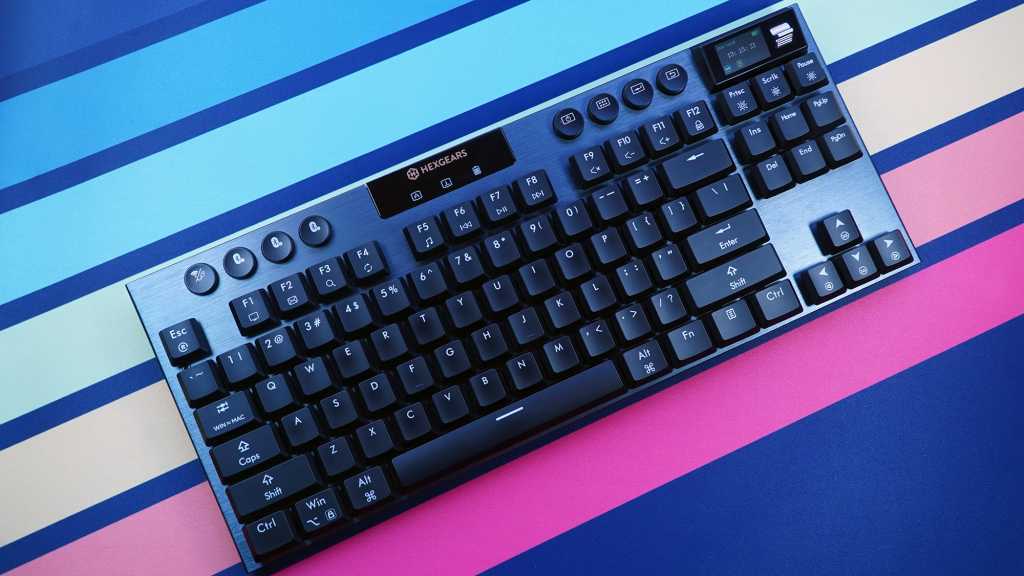Expert's Rating
Pros
- Tons of features for the price
- Long battery life
- Hot-swap switches
- Light weight
Cons
- Screen is almost useless
- No per-game profiles
- Imitation style
Our Verdict
The Immersion A3 is shamelessly cribbing on Logitech’s gaming keyboard style, and its screen is near useless. But its long list of features, light weight, low profile, and great battery life help it stand out as a budget alternative to similar wireless mechanical designs.
Price When Reviewed
This value will show the geolocated pricing text for product undefined
Best Pricing Today
Can you get all the same features from a $300 keyboard in one that costs less than half the price? Well, no. But you can get pretty close. And if you’re on a budget, that’s more than good enough. So it is with the Hexgears Immersion A3, a keyboard that tries to bring flagship features to a far more attainable price point.
Further reading: Best wireless keyboards 2024: Top Bluetooth and USB models
This wireless, hot-swap, RGB, screen-equipped keyboard hits most of the high points for modern name-brand mechanical designs, but starts at $130 (and just $110 with a coupon at the time of writing). It’s weird to say this about a keyboard with a triple-digit price tag, but that makes it a deal.
It’s weird to say this about a keyboard with a triple-digit price tag, but that makes it a deal.
There are a few corners cut here, as you’d probably expect, and it’s clearly using a lot of whitebox hardware. But it’s packed with features at a good price.
Hexgears Immersion A3: Design
In terms of looks and layout, the Immersion A3 is obviously, ahem, “inspired” by Logitech’s G915. It’s using the same sleek, low-profile look with black keycaps on brushed metal, the same TKL setup. Hell, it’s even sporting the same separate, circular control buttons on an extra top row. I wouldn’t quite call it shameless…okay, yeah. It’s shameless.
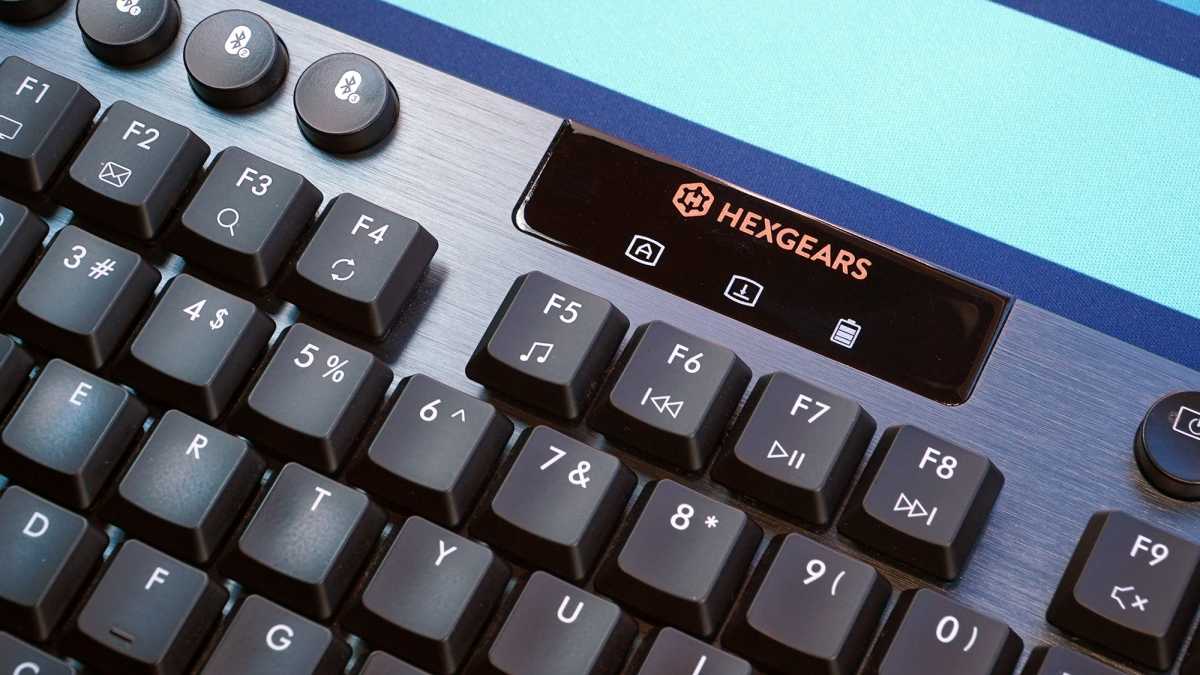
Michael Crider/Foundry
The biggest departure from Logitech’s design is that little screen up in the right corner, squishing the volume wheel into a much smaller rocker. Screens on keyboards are a trend at the moment, with examples from SteelSeries, Asus, and Razer, among tons of smaller mechanical manufacturers.
And I’ll say here what I’ve said in every other relevant review: tiny screens on keyboards are dumb. They’re especially unwelcome on wireless boards where battery is at a premium. Little bitty screens on a device you use while looking at another screen are an inherently bad idea, and I can’t wait for this trend to die.
On the Immersion A3 it’s pretty much useless — you can only use the rocker next to it to adjust the lighting, something that’s already very easy to do with the function layer. (In fact those buttons are already right below the screen). The only other thing you can do with this tiny display is change the language of the display. Though it defaults to a clock, you need the desktop software to actually change the time. So dumb!
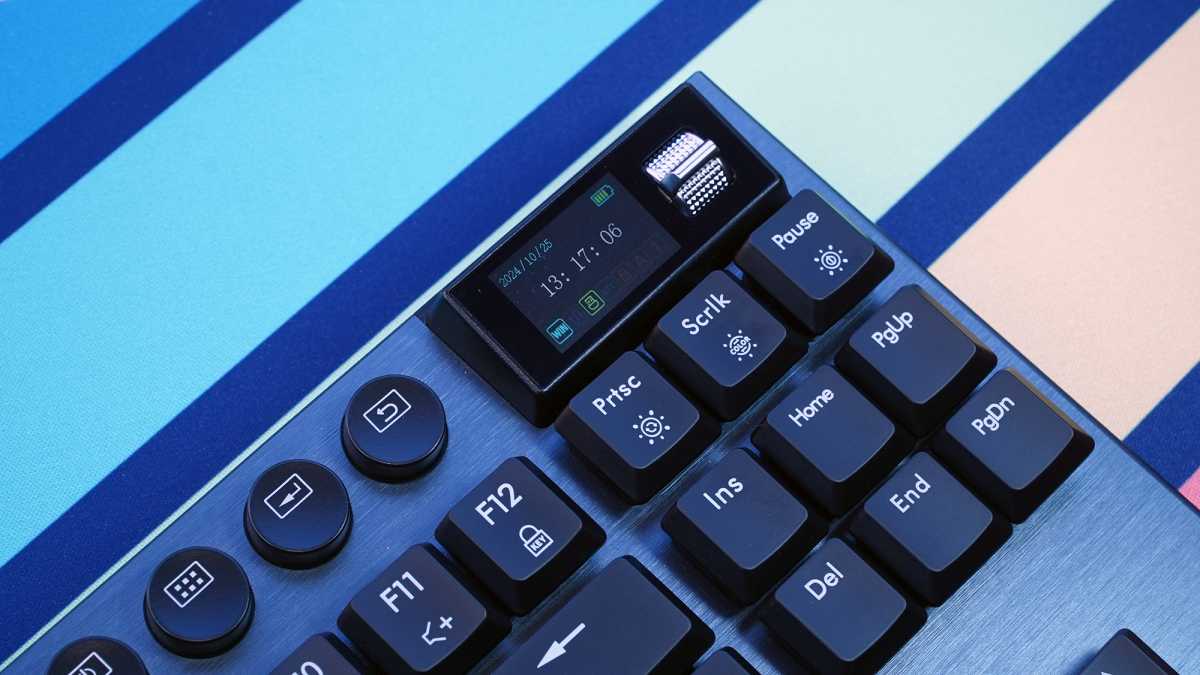
Michael Crider/Foundry
I think that this thing is so limited because it’s a whitebox part that’s being used in dozens of different keyboards that have recently come out. I found five different ones with just a quick Amazon search, all with what looks like an identical or near-identical screen running on the same pre-loaded software, all from different brands.
But, having complained about how dumb this screen is, it at least doesn’t negatively impact anything else on the keyboard, aside from wasting physical space. Even when it’s on it doesn’t suck down too much battery since it’s mostly static. And you can turn it off and maximize the keyboard’s battery life by pressing the circular power button. Which, confusingly, is neither the power button for the keyboard (that’s a switch on the top edge) or your connected device. See? Dumb.
Hexgears Immersion A3: Features
Otherwise, the keyboard is surprisingly straightforward. You get low-profile key switches that are also hot-swap, a hard-to-find combination. These are supplied by Kailh, a good option with a good selection of choices (even though it’s far fewer than with standard Cherry MX-compatible switches). And Amazon is selling this keyboard with linear (white), tactile (black), or clicky (grey) switches pre-installed. It’s great that they’re offering all three without the need to buy extra switches.
The tactile switches included on this review unit are pretty good, similar to the custom ones on the Lofree Edge, though nowhere near as cushioned and quiet. I was able to adjust to typing on them extremely quickly, helped in no small part by the standardized TKL layout. Finding replacement or custom keycaps to swap out for the dull ABS ones here won’t be too difficult thanks to the cross-shaped stems, though full-height Cherry caps probably won’t work.
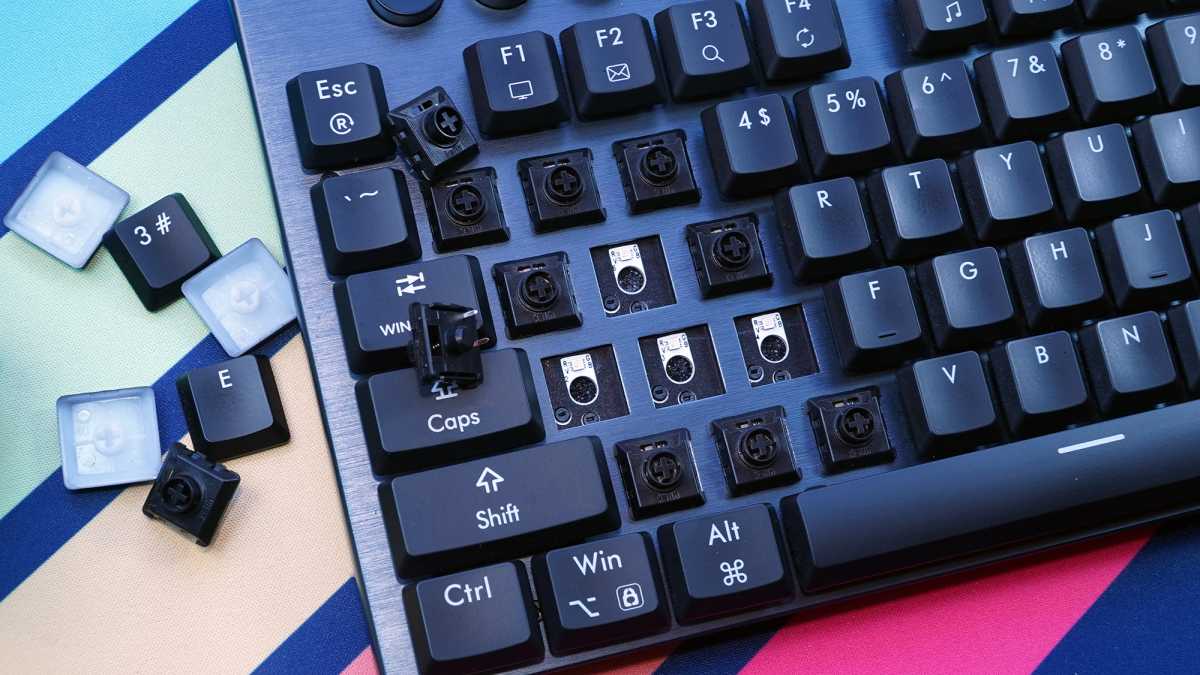
Michael Crider/Foundry
You get RGB lights (a bit on the dim side) with the usual options for animations. You get a nice brushed aluminum top with a blue-black hue. The plastic bottom feels a little cheap, but I appreciate the double keyboard feet for three adjustable angles. The trim on the top near the power switch is a bit chintzy, but hardly unforgivable, and I like that you can stow the 2.4GHz wireless dongle right in the body.
And even for a mid-sized keyboard, you might want to. Despite having a massive 5800mAh battery — bigger than most smartphones! — it’s shockingly light at just a hair over 1.5 pounds (.75 kilograms). Between that and the slim profile, you might be tempted to throw this thing in a laptop bag… but with the sharp floating keycaps, I’d recommend a dedicated carrier first.
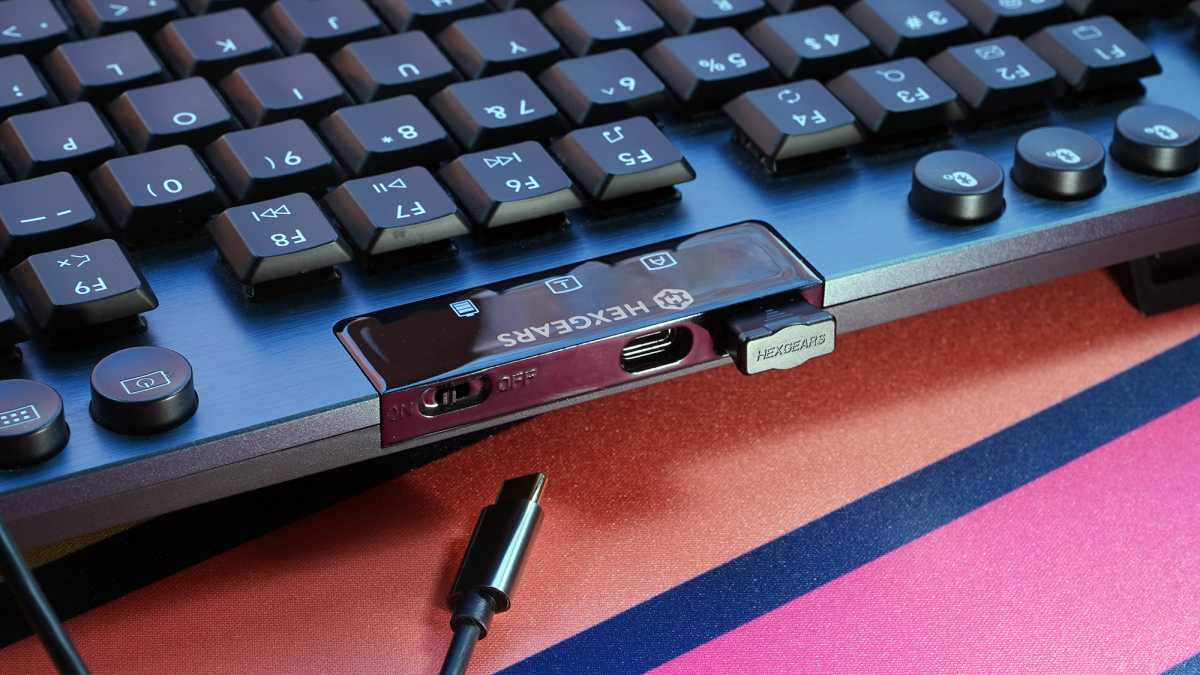
Michael Crider/Foundry
All in all, it’s a very solid package. Not premium by any means — the cheap plastic on the control buttons and trim gives it away, as does the lack of a wrist rest. But the Immersion A3 is more than acceptable for a budget board with dreams of greatness.
Hexgears Immersion A3: Typing and gaming
Actually using this thing for a couple of weeks surprised me. While it lacks the refined feel low-profile boards like the Nuphy Air or Lofree Edge, it’s rock-solid in both dongle-based wireless and Bluetooth mode. I was able to type away for hours, then switch seamlessly into PC games without any hiccups.
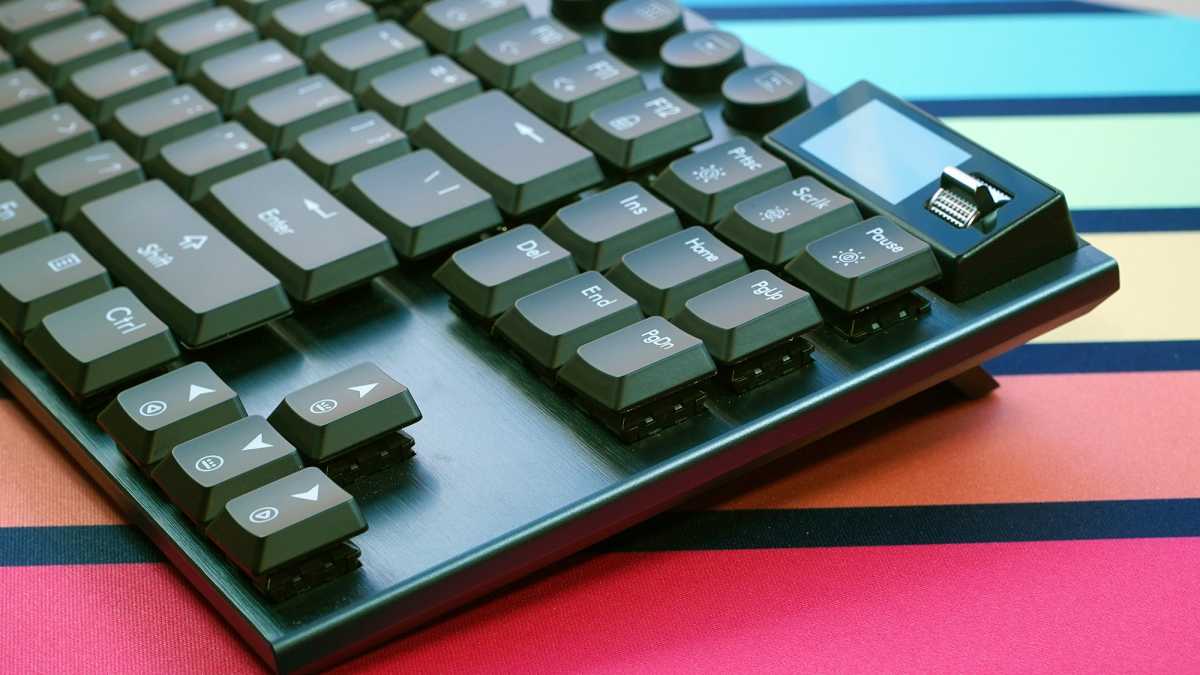
Michael Crider/Foundry
I should mention gaming, because Hexgears advertises this as a gaming keyboard. And it commits one of my cardinal sins for gaming boards: Omitting an option to bind specific programmed layouts to specific games. Hexgears does offer its own downloadable Windows driver program, which you’ll need to sync and correct the display’s clock, if you care. It’s dull, but serviceable, offering three different profiles and the usual color adjustment and macro programming.
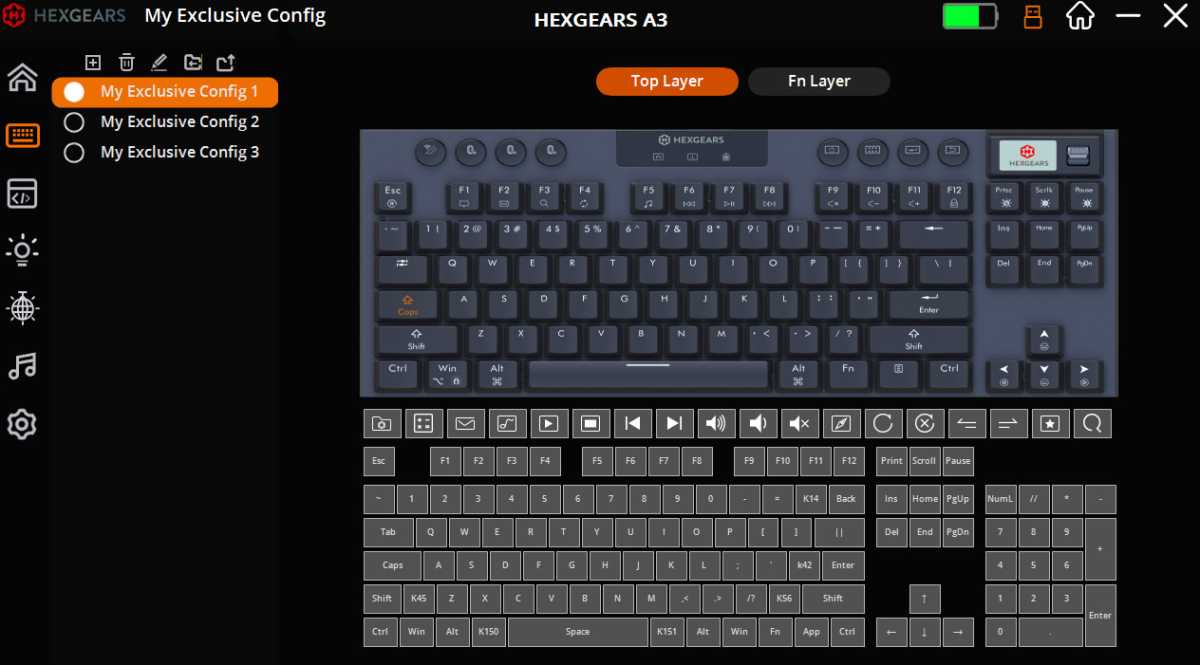
Michael Crider/Foundry
But there’s no way to launch profiles with games. For a gaming board that bills itself as premium, even one that’s far cheaper than its competition, I have to ding it. The wired G.Skill KM250, which remains my go-to gaming board budget pick over a year later, can get away with it for under $50. The Immersion A3 cannot.
Hexgears Immersion A3: Conclusion
Even after nitpicking the software and the vestigial screen, I have to admit that this board is a good deal at $130 and a great one at $110. If you like Logitech’s low-profile looks but think its gaming boards are overpriced (and they are!), it’s an excellent alternative. If you’re looking to use this as a base for some upgrades, I’d recommend a set of low-profile PBT keycaps and some quiet switches.
The Immersion A3 is a good deal at $130 and a great one at $110.
The Immersion A3 makes some notable compromises to hit its budget price, but none of them are deal breakers. If you want more flexible programming or you prefer a smaller or larger layout, consider a Nuphy Air or Keychron K series instead.

